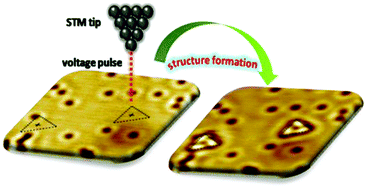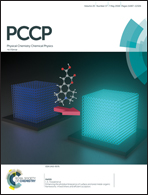Quaterrylene molecules on Ag(111): self-assembly behavior and voltage pulse induced trimer formation
Abstract
The self-assembly behavior of quaterrylene (QR) molecules on Ag(111) surfaces has been investigated by scanning tunneling microscopy (STM) and density functional theory (DFT) calculations. It is found that the QR molecules are highly mobile on the Ag(111) surface at 78 K. No ordered assembled structure is formed on the surface with a sub-monolayer coverage up to 0.8 monolayer due to the intermolecular repulsive interactions, whereas ordered molecular structures are observed at one monolayer coverage. According to our DFT calculations, charge transfer occurs between the substrate and the adsorbed QR molecule. As a result, out-of-plane dipoles appear at the interface, which are ascribed to the repulsive dipole–dipole interactions between the QR molecules. Furthermore, due to the planar geometry, the QR molecules exhibit relatively low diffusion barriers on Ag(111). By applying a voltage pulse between the tunneling gap, immobilization and aggregation of QR molecules take place, resulting in the formation of a triangle-shaped trimer. Our work demonstrates the ability of manipulating intermolecular repulsive and attractive interactions at the single molecular level.



 Please wait while we load your content...
Please wait while we load your content...